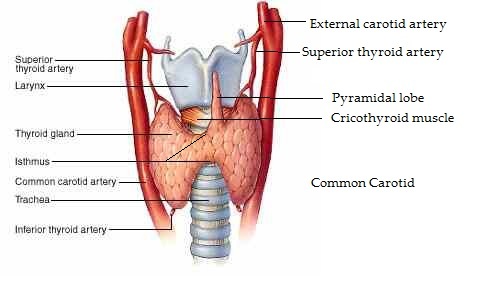Thyroid Gland
Definition
Is an important endocrine gland which secretes the hormone thyroxine
Situation
Situated in the front of neck.
In front of the larynx and trachea
At the level of 5th, 6th and 7th cervical vertebrae
Structure
Highly vascular
Fibrous capsule
Two lobes right and left
One on either side of the trachea
Narrow isthmus connecting the two lobes
Histology
The gland consists of cubical epithelial cells
The epithelial cells form spherical follicles
Follicles contain a protein called colloid
The colloid combines with the hormone thyroxine and stores the hormone - releases it when needed.
Also the gland has parafollicular cells called C - cells - calcitonin
Blood supply :
superior thyroid artery from external carotid
inferior thyroid artery from the thyrocervical trunk of the subclavian artery
both the arteries are paired ( i.e. right and left)
venous return into the internal jugular veins
Relations
Anteriorly : fascia, flat muscles of the neck and skin
Laterally: carotid sheath
Medially: trachea, oesophagus and tracheo-oesophageal groove and recurrent laryngeal nerves
Posteriorly: parathyroids, two parathyroid glands lie against the posterior surface of each lobe
Function
Hormones produced and their clinical significance
Thyroxine - triiodothyronine, tetraiodothyronine (T3 and T4) - deficiency causes hypothyroidism excess causes hyperthyroidism - thyrotoxicosis - which can be primary or secondary
Enlargement of the gland causes a swelling in front of the neck called goitre.
Applied Anatomy
Enlargement of the thyroid gland is called a goitre
Goitre may be in euthyroid, hypothyroid or hyperthyroid status
Thyroid nodules - adenoma or carcinoma



